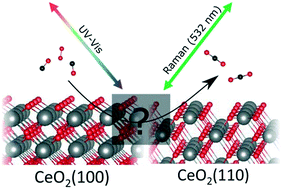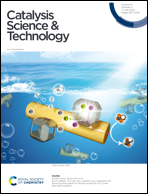Influence of gold on the reactivity behaviour of ceria nanorods in CO oxidation: combining operando spectroscopies and DFT calculations†
Abstract
Au/CeO2 catalysts are commonly used for low-temperature CO oxidation. While many studies focus on the properties of gold and their relevance for activity, the influence of the support properties has received less attention. In this temperature-dependent study, we examine the relation between structure and activity for oxidation of CO over ceria nanorods (with/without gold), exhibiting CeO2(110) and CeO2(100) termination. Using ceria nanocubes with CeO2(100) termination as a reference enables us to extract facet-specific characteristics. To characterize the adsorbate and structural dynamics we employ operando Raman and UV-vis spectroscopy combined with density functional theory (DFT) calculations. Our results reveal the superiority of CeO2(110) over CeO2(100) facets for CO oxidation as a result of their lower defect formation energy. Our findings are supported by the observed dynamics of the surface peroxide, the subsurface oxygen, and the bulk reduction under operando conditions. The lower activity of the unloaded samples can be compensated by higher temperatures (>120 °C) allowing new insight into the role of gold for CO oxidation activity. Our study highlights the importance of the surface termination for a detailed mechanistic understanding of ceria-based catalysts.



 Please wait while we load your content...
Please wait while we load your content...